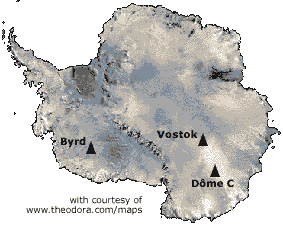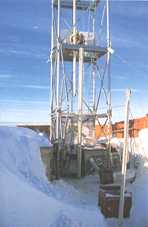|
|
|
|
Coring into antarctic ice
Following the International Geophysical Year (IGY, 1957-58), scientists announced that the layers of snow and ice that make up the Antarctic ice cap are recording in a continuous fashion - and have been for millions of years - a certain number of parameters that characterise the evolution of the climate and the atmospheric environment at world level: temperatures, precipitation, composition of the atmosphere, and aerosol concentrations, among other things.
If one could manage to bore sufficiently deeply, one could reconstitute the atmospheric history of Planet Earth. The initial soundings are rudimentary: the scientists used oil techniques by exploding small charges in order to record the rebound from the bedrock of the vibrations so provoked. In the course of the years following the IGY, they drilled boreholes in the ice cap, examined the sides of the glacier, removed samples and surveyed the strata. It was the Americans who perfected the first samplers capable of boring to a depth of several hundred metres. In 1970, the Soviets and the French reached a depth of 1,000 metres; the first by boring at the Vostok station, the second at C Dome.  Today, glaciologists have recourse to electro-mechanical samplers that allow for new depths to be reached: 2,164 metres by the Americans who in 1967-68 were boring at the Byrd station in Antarctica, and 3,350 metres, in 1996, by the Soviets who were boring with French equipment and technicians at the Russian Vostok station, which represented nearly 450,000 years of climatic and environmental archives.
Today, glaciologists have recourse to electro-mechanical samplers that allow for new depths to be reached: 2,164 metres by the Americans who in 1967-68 were boring at the Byrd station in Antarctica, and 3,350 metres, in 1996, by the Soviets who were boring with French equipment and technicians at the Russian Vostok station, which represented nearly 450,000 years of climatic and environmental archives.
|

